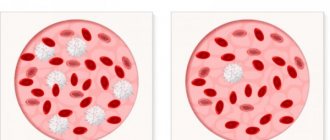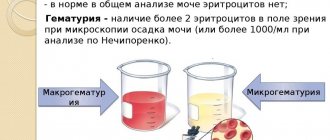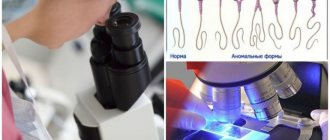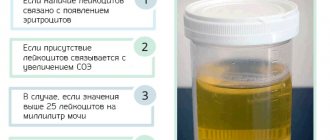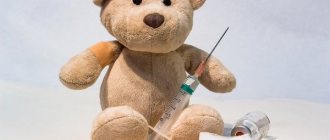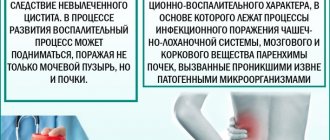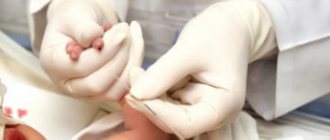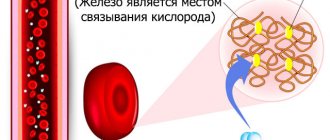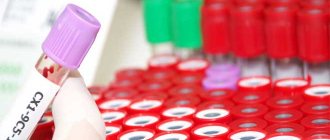If, during testing, leukocytes were detected in the child’s urine, it means that a disease is occurring in the body, which is important to identify for timely treatment. High levels of leukocytes in a child’s urine are accompanied by characteristic symptoms, in which one should not hesitate or self-medicate, but urgently take the baby for examination. What reasons provoke an increased number of leukocytes in the urine, how to treat the disease, and what preventive procedures will help avoid recurrence?
Preparing for a urine test for leukocytes in a child
In order for the test results to give the most accurate results, it is important to properly prepare the baby for the procedure, following all the doctor’s recommendations and instructions. To ensure that the urine does not have unnecessary uncharacteristic inclusions and does not have a suspicious color, 2-3 days before the test you need to adhere to a diet that excludes foods that affect the color of urine, as well as dishes that provoke an increase in certain indicators in the urine.
In an infant, urine can be collected in a sterile container using a urinal; in older children, urine is collected, as in adults. In order for a urine test to show correct results, you need to collect morning urine, take the middle portion, and pour the first drops into the toilet. Urine must be collected in a sterile container, which you can prepare yourself or buy at a pharmacy. If you do not adhere to the rules for collecting urine and do not carry out hygienic procedures for the child, then the leukocyte level may be 50-60 units.
How to properly collect urine for analysis
Follow the recommendations and the research results will be reliable:
- for general analysis you need morning urine produced immediately after waking up;
- prepare a sterile jar, special container or plastic container;
- A useful device – a urine collector – will help collect the required amount of fluid from infants. The thick plastic bag has a teardrop-shaped hole. Wash the baby, dry the perineum or penis well, secure the bag so that the urine immediately gets into it. Perform the operation in the morning, immediately after waking up;
- For older children, be sure to wash the genitals with baby soap, thoroughly remove any remaining soap suds, then give them a jar or container for the material;
- After collecting the liquid for analysis, take it for research. If it is not possible to immediately transfer the container to the laboratory, store the container in the refrigerator. The laboratory assistant will advise you on storage times and rules.
If the test results show more leukocytes than normal, the doctor will prescribe additional tests, and urine culture is often performed. A special test shows the type of infectious agent that attacked the child’s body. Bacterial culture is required to determine the antibiotics that most actively suppress the activity of the identified pathogen.
Normal for girls and boys
The norm of leukocytes in the urine of a newborn baby and a one-year-old child exceeds the indicators of older children, and ranges from 8-10 units in girls, slightly less than 5-6 in a boy. If the baby is 1-3 years old, there are no inflammatory processes in the body and the child is healthy, then the number of leukocytes is 2-3 units; at 3 years and older, leukocytes in the urine are 11. In adolescents, the red corpuscle in the urine is present in smaller quantities and fluctuates in the range of 1-2 units. There are different methods according to which the indicators will fluctuate by several units, which is why there is confusion in the interpretation of the results. Thus, when taking urine tests according to Nechiporenko for children, the norm is 2-4 units, and according to the Addis-Kakovsky method, the normal value should not exceed 2 units.
If the urine test exceeds the norm of leukocytes, this indicates that diseases are occurring in the body, which provoke changes in indicators.
Reasons for the increase
The reasons for the fact that completely elevated leukocytes are found in the urine of children are very diverse, but most often the root cause is a severe inflammatory disease. For example, with pyelonephritis, a child’s urine analysis shows leukocytes of 20-30 units, while bacteria are visible in the urine, protein also exceeds normal levels. This is a large excess of the norm, so urgent medical attention is required. Such indicators can occur in acute forms of cystitis or urethritis, so in no case should you give your baby medicine yourself.
The reasons for the increase in leukocytes in the blood and urine are congenital pathologies of the development of the organs of the genitourinary system. Allergies also affect test results, so if a child suffers from such a pathology, then 40-50 leukocytes may also appear in the results. Even if the baby feels normal and does not have a fever, and there are a lot of leukocytes in the urine, this is also a reason to visit a doctor.
Diseases that cause symptoms of leukocyturia
Diseases of an infectious nature are the most common cause of childhood leukocyturia. Such diseases are manifested by symptoms of fever, decreased general tone, weakness and impaired urination. The urge becomes more frequent, and the process of urination itself causes pain. Small children often experience urinary incontinence, both at night and during the day. In addition to this, nagging pain often occurs in the lower abdomen or lower back. The latter is typical for inflammation of the kidney, so such pain is almost always felt from the pathology.
When observing such symptoms, they resort to a general blood and urine test in the child, as well as an ultrasound examination of the bladder and kidneys. Sometimes the doctor may prescribe cystoscopy - a visual examination of the inner surface of the bladder with a special device - a cystoscope. If the studies carried out do not allow an accurate diagnosis of the condition, a urine test is performed using the Nechiporenko, Addis or Kakovsky method. In addition, urine is examined for microflora and its susceptibility to antibiotics, which allows for the correct selection of therapeutic drugs. The essence of treatment is not only to suppress the symptoms that appear, but also to eliminate the cause itself - the microorganism that caused the inflammation.
The course of therapy consists of penicillin antibiotics and cephalosporins, as well as urogenital antiseptics, such as furagin. In addition to the main medications, symptomatic assistance is provided: to reduce the temperature, paracetamol and indomethacin are used, and to normalize the urinary process, herbal teas and herbal decoctions, for example, from lingonberry leaves are used.
A pathology of the ureteral organs, either hereditary or acquired, can play a decisive factor in a child’s urinary system disease, since such pathologies increase the body’s susceptibility to bacterial infection. The most common pathologies:
- Disturbances in the normal structure of the renal pelvis,
- Loss of one kidney or its absence due to pathological development of the body,
- Ureteral reflux,
- Narrowing of the ureteral canal or injury to it,
- Pathological dysfunction of blood flow in the ureteral system.
If such pathologies are suspected in children, ultrasound, CT, MRI, radiography, cystoscopy, and sometimes radionuclide testing are performed, since conventional urine and blood tests in this situation will only help determine the degree of pathology, and not its nature. When treating this type of disease, surgical intervention is indispensable.
Urethritis and vulvovaginitis. The first is inflammatory processes in the urethra in boys, the second is in the vaginal mucosa of girls. The symptoms are as follows: itching of the external genitalia and a burning sensation in them. Often these diseases are accompanied by discharge of an unusual color with an unpleasant odor. Such conditions are diagnosed by inserting a catheter into the bladder to collect a urine sample. If the urine from the catheter does not contain leukocytes above the norm, the child should be shown to an andrologist (boy) or gynecologist (girl). Treatment is prescribed based on examination findings. Antibacterial drugs are used, and girls are advised to douche and wash the vulva with special disinfectant solutions, decoctions and infusions.
Infantile dermatitis is the most commonly identified cause of an increase in the level of leukocytes in the urine of infants. Improper use of diapers can lead to this effect. Diapers that are not changed on time lead to prolonged contact of the baby's skin with urine and feces, which can cause allergic reactions and skin rash. When such a problem occurs, the baby becomes capricious, often cries and reacts painfully to washing and changing the diaper.
Swelling of the skin folds and genitals in the absence of visible diseases of the urinary system suggests the cause of infantile leukocyturia - dermatitis, however, the final diagnosis can be made only after analyzing urine from a catheter.
Symptoms of the disease
If a small child or teenager has increased leukocytes in the blood, such indicators mean that inflammatory processes are progressing in the body, which manifest themselves with similar symptoms:
- temperature and deterioration of general health against the background of intoxication of the body;
- painful trips to the toilet, during which the volume of urine is limited to a few drops;
- visualization of inclusions, which may be bloody, purulent or white mucous, when urinating in urine;
- a sharp deterioration in health if the inflammation is advanced and spreads to the kidneys (the child becomes ill, he may lose consciousness or become delirious);
- white coloration of urine, which indicates severe damage to the kidneys by the microbacterium tuberculosis, therefore, with such a symptom, you urgently need to take the baby for examination.
What are leukocytes and can they be in urine?
Leukocytes
Leukocytes or white blood cells are important components of blood. Their main function is the ability to phagocytosis - digestion of particles. Most often it is used to destroy foreign agents in our body.
In order to answer the question of whether leukocytes can appear in a child’s urine, it is first necessary to understand how urine is formed in our body.
The process of urine formation
The process of urine formation consists of three processes: filtration, reabsorption and secretion.
Filtration
The essence of filtering is clear from the name. This process occurs in the so-called renal glomeruli. Blood is brought through vessels to them. The liquid and its dissolved compounds then pass through the membrane.
In this way, high-molecular compounds are separated, and electrolytes, water, cellular elements and other compounds form primary urine. This is the meaning of the first process of urine formation.
Reabsorption
Reabsorption is the process of reabsorption of substances. Some substances that have passed through the filtration barrier may be needed by our body in the future. Therefore, they are reabsorbed in the renal tubules.
The main substances that undergo reabsorption are: glucose, amino acids, sodium, calcium, magnesium, potassium ions, as well as chlorides, sulfates, phosphates and even water.
Secretion
Secretion is the process of releasing substances into the urine, for example, using special carriers. In this way, the body gets rid of drugs, hydrogen protons, various organic acids and toxins. As a result, secondary (final version) urine is formed.
Thus, thanks to all three processes, the final products of metabolism are eliminated.
So what is the answer to the question posed earlier: can leukocytes be in the urine? The answer is clear - they can. The number of white blood cells plays a major role in diagnosing diseases.
Treatment of leukocyturia in a child
After all the tests have been completed and the diagnosis is confirmed, the doctor prescribes drug therapy. If the root cause of leukocyturia is an infectious disease, then mandatory antibacterial therapy is required, the duration of which should be at least a week. Additionally, painkillers, diuretics, and uroseptics are prescribed, which normalize the functioning of the kidneys and prevent the stagnation of excess fluid in the body.
During this period, it is important to maintain bed rest, stay warm, eat bland food, and adhere to the drinking regime. When you have a fever, you need to drink warm herbal chamomile tea, unsweetened compotes, fruit drinks, and fresh juices. From food, it is recommended to eat light food with a minimum content of salt and other seasonings. The temperature in the room should be comfortable, and it is important to maintain the optimal level of humidity.
If all the rules are followed, the child’s condition improves within 3-5 days. If there is no improvement and the picture of the tests is bad, it is recommended to take repeated tests and undergo further examination. If the red cells in the analysis are elevated, this may also indicate the development of a dangerous disease such as leukemia. The red body begins to attack malignant cells, which means that in tests the number of leukocytes will be significantly higher than normal.
How to prepare and properly collect urine for analysis
One of the common causes of false leukocyturia is incorrect collection of urine for analysis. How to properly collect urine depends on the age of the child.
Older children who are able to control the process of urination follow the following rules when collecting material:
- Toilet the genitals with warm water. It is not advisable to use soap and other hygiene products - soap suds may remain in the folds of the skin, and this will distort the diagnosis.
- The child flushes the first portion into a potty or toilet, and then pees into a sterile container. Before urinating, the boy needs to move the foreskin from the head of the penis, and the girl needs to spread the labia with her fingers. This will prevent the accidental release of leukocytes from the external genital organs into the urine.
After collection, the container is capped and delivered to the laboratory.
To avoid changes in the color indicator of urine, a day before the test, you need to remove coloring foods (citrus fruits, beets, carrots) from the child’s diet.
Often, parents are lost and do not know how to collect a urine test from babies who are not yet able to control the urge to urinate. There are 2 ways:
- Guard. Small children pee almost immediately after sleeping or after drinking. You need to keep an eye on the baby and place the jar under the stream in time. Boys manage to collect urine almost without problems, but girls do not always succeed.
- Soft urinal. The pharmacy sells polyethylene sterile urine bags for babies. The device is attached to the child's perineum with a hypoallergenic patch without causing discomfort. After the bladder has been emptied, the urine is poured into a sterile container.
You cannot squeeze urine out of a diaper or diaper or pour it from a potty for research. The diaper may retain white blood cells, but the fabric and surface of the potty are not sterile. Submitting incorrectly collected material will distort the result.
Prevention
Preventive measures should primarily be aimed at preventing relapses and improving the protective properties of the child’s body. Much attention needs to be paid to maintaining the baby’s personal hygiene. Girls need to be washed so that microorganisms from the anus do not fall on the outer labia, since the entry of specific intestinal microbacteria into the vagina causes severe infectious inflammation, which is then more difficult to get rid of. It is also important to strengthen the immune system, eat healthy food, fresh fruits and vegetables, toughen up, and exercise. Take vitamin complexes and supplements only as prescribed by a doctor and do not self-medicate.
What to do if your leukocyte count is high
Leukocyturia requires treatment. To determine the cause and select the necessary therapy, the doctor prescribes additional diagnostics:
- Ultrasound of the kidneys and bladder;
- urine examination according to Nechiporenko, according to Zimnitsky;
- UAC;
- contrast radiography;
- bacterial sowing;
- cystoscopy;
- CT or MRI.
If there are no abnormalities in the urinary system, then the child is referred for consultation to an endocrinologist, infectious disease specialist, allergist or other specialists. A comprehensive examination will reveal the cause of the increase in leukocyte cells in the urine and select the necessary treatment.
How to take a urine test correctly
The complex procedure for taking a urine test for the level of leukocytes generally consists of two large blocks - these are preparatory measures and the direct collection of biomaterial and its delivery to the laboratory. As modern clinical practice shows, the first stage, regardless of the type of urine analysis, is almost identical in all cases:
Diet. There is no special nutritional plan for newborns and infants, since they receive all the necessary nutrients from mother's milk, or by consuming specialized formulas. If the baby actively uses complementary foods, or is already a fairly old child and eats well, then 3 days before the intended collection of the material, it is necessary to adjust his diet, excluding from it all spicy, salty and sweet foods
In addition, with great caution you should consume dairy products, exotic fruits, legumes, mushrooms and, of course, fast food, soda, cocoa, strong tea and coffee;
Mode. Newborns and infants are not allowed to change their usual routine.
They should eat at the same time, regularly walk outside, and also carry out other activities that are familiar to them without shocks and sudden changes. For older children, it is advisable to limit physical and mental activity three days before taking biological fluid;
Medicines. In general, modern doctors recommend stopping the use of any types of drugs during the preparatory period for 3 days. In some cases, this cannot be done, especially if the baby is already seriously ill and must take the medicine constantly. In this case, it is necessary to notify the pediatrician, specialist and diagnostician about the situation, providing all the names of the drugs used, their dosage, dosage regimen and other data as necessary.
Direct collection of biomaterial for analysis can vary significantly depending on the diagnostic technique. So, when collecting urine for analysis one time, it is advisable to only have a light snack in the evening. In the morning you should not eat food at all, but donate biomaterial on an empty stomach during the first act of urination.
In this case, an “average portion” of urine should be placed in a sterile container purchased at a pharmacy and intended for storing liquid biological substances; accordingly, the first few seconds of urination are skipped, after which the jar is filled on average by half, since analysis requires from 50 to 100 milliliters of liquid.
If daily urine collection is necessary, it is carried out as follows: the first urination is completely skipped, all subsequent urinations are collected in a sufficiently large container. Throughout the day, the vessel with the biomaterial is stored in the refrigerator and is replenished with new portions of urine.
Early in the morning, the vessel is shaken, after which about 50-100 milliliters of liquid is poured into a sterile container. On his sticker, in addition to the last name, first name and patronymic, as well as other data of the little patient, it is necessary to indicate the volume of urine that was collected during the day.
Ideally, the sample will be delivered to the laboratory within a maximum of 2 hours after initial preparation. In some cases, biological fluid in a sterile, lidded container can be stored in the refrigerator for up to 4 hours - this primarily applies to a one-time urine collection, and not its daily counterpart.
What can an elevated level of leukocytes in a child’s urine tell you about?
Leukocyturia (increased levels of leukocytes in the urine) indicates the presence of an internal inflammatory process.
This may be chronic or acute kidney disease, urinary tract infection, or some systemic or endocrine diseases. It is important that leukocytes can appear in the urine even if the baby does not have a fever or other signs of an acute process. In this case, leukocyturia will be the first symptom of a developing disease. It is necessary to start treatment in time, before the disease becomes chronic and leads to serious kidney damage.
A significant increase in leukocytes in the urine can be noticeable without laboratory tests. The urine becomes cloudy, sometimes there are white flakes, and the smell changes. This is an extremely alarming symptom. If you notice such changes when emptying your child's potty, contact your doctor immediately!
The pediatrician explains how to make or exclude the diagnosis of leukocyturia and determine the extent of the disease.
What to do if a child’s white blood cells are elevated?
If there is a high content of clear blood cells, the pathology must be treated with conservative methods. Leukocytosis in the urine means that there is a tendency to chronic inflammation, which must be eliminated in childhood. The approach to the problem is complex. The main goal of doctors is to remove the obstacle to the flow of urine and destroy the pathogenic flora with medication.
If the leukocyte count is high, the following intensive care regimen is recommended for the child:
- Taking antibiotics. If the leukocyte count is abnormal, these are representatives of the amoxicillin group, selected only by the local pediatrician.
- Probiotics, which alleviate the effects of antibacterial therapy, normalize the composition of the intestinal microflora. These can be Hilak Forte, Linex, Bifidumbacterin, Laktovit, Prelax.
- Vitamins presented in natural products or multivitamin complexes. They should be used according to the age category of the child.
- In addition, careful adherence to the rules of intimate hygiene of the external genitalia to accelerate the desired therapeutic effect.
After taking the tests, be sure to show the results to your pediatrician. If necessary, the doctor will refer you for consultation to a nephrologist, allergist or endocrinologist. Treatment of diseases in infants and older children is carried out according to an individual scheme. Parents should not buy drugs that a neighbor’s child used to get rid of a similar pathology.
